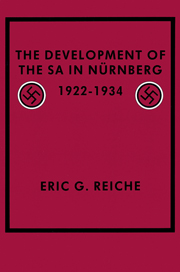Book contents
- Frontmatter
- Contents
- List of tables, figures, and maps
- Acknowledgments
- Introduction
- Abbreviations
- 1 Nürnberg and the emergence of National Socialism
- 2 Enter the stormtroopers: the Nürnberg SA, 1922–1923
- 3 “The guarantor of unity”: Nürnberg's SA between 1924 and 1929
- 4 Ready to assume power: the SA during the Great Depression
- 5 “The party bosses are our misfortune”: the Stegmann revolt, November 1932 to March 1933
- 6 The illusion of power: from the advent of the Third Reich to the Röhm putsch
- Conclusion
- Notes
- Bibliography
- Index
- Frontmatter
- Contents
- List of tables, figures, and maps
- Acknowledgments
- Introduction
- Abbreviations
- 1 Nürnberg and the emergence of National Socialism
- 2 Enter the stormtroopers: the Nürnberg SA, 1922–1923
- 3 “The guarantor of unity”: Nürnberg's SA between 1924 and 1929
- 4 Ready to assume power: the SA during the Great Depression
- 5 “The party bosses are our misfortune”: the Stegmann revolt, November 1932 to March 1933
- 6 The illusion of power: from the advent of the Third Reich to the Röhm putsch
- Conclusion
- Notes
- Bibliography
- Index
Summary
The origins and development of the Nürnberg SA were closely tied to those of its parent party. Without the NSDAP there obviously would have been no SA. The political, social, and economic developments that elevated the NSDAP from a debating circle to a mass movement also provided the SA with a growing number of active members. The party program might have been vague, platitudinous, and contradictory, but Hitler's promise to lead Germany from weakness to strength attracted a growing number of people to the party and into the ranks of the SA. The establishment of Hitler's government not only gave the SA unprecedented scope for its activities, but led to demands for even greater powers, which culminated in the execution of the major SA leaders and the SA's subsequent demise. Yet as the history of Nürnberg's SA showed, an identical leader and similar reasons for growth resulted neither in a congruity of aims nor in an identical membership.
The reasons for the rapid growth of the SA in 1922-23 and those for its even more phenomenal increase between 1930 and 1934 were similar only in part. The existence of a proto-Nazi movement in Nürnberg under Streicher's leadership before October 1922 provided both the NSDAP and the SA with a potential and sizable group of members. Although the bulk of Nürnberg's DSP members followed Streicher into the NSDAP, there is little statistical evidence that these previous followers of Streicher joined the SA in large numbers.
- Type
- Chapter
- Information
- The Development of the SA in Nurnberg, 1922–1934 , pp. 222 - 230Publisher: Cambridge University PressPrint publication year: 1986



